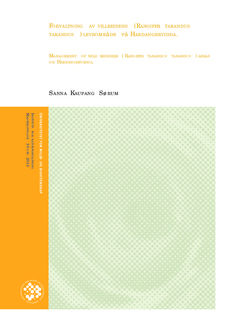| dc.description.abstract | Norge har et internasjonalt ansvar for å ta vare på villrein (Rangifer tarandus tarandus).
Likevel viser studier at bygging i villreinområder har økt med omlag 17 % fra 1986 til 2005.
Den siste tiden er det gjort en rekke tiltak som skal bidra til en mer helhetlig og effektiv
forvaltning av villreinens leveområde på Hardangervidda, for eksempel regional plan for
Hardangervidda. Planen skal gi retningslinjer for en langsiktig og helhetlig strategi for bruk
av villreinområdet, samt nærliggende områder som kan påvirke villrein.
I fire utvalgte kommuner rundt Hardangervidda: Tinn, Nore og Uvdal, Hol og Eidfjord
varierte det hvorvidt villrein ble vurdert i inngrepssaker som berører villreinens leveområde i
perioden 2008 til 2012. Samtlige kommuner innvilget en stor andel saker. Resultatene fra
denne undersøkelsen viser at det ikke ble gitt flere avslag i sone B, som har de strengeste
retningslinjene. I flere saker ble hensynet til villrein nedprioritert, eller ikke vurdert i
sakspapirene. Rådmannens innstilling om avslag ble også i flere tilfeller ikke fulgt når endelig
vedtak ble fattet i kommunalt utvalg. Dette gjaldt spesielt Nore og Uvdal kommune. Etter
politisk vedtak skal saker som kan berøre villreinens leveområde sendes til villreinnemnda for
Hardangerviddaområdet for uttalelse. Nore og Uvdal kommune var eneste blant de fire
kommunene som sendte inn samtlige innvilgede saker i sone B til villreinnemnda for
uttalelse. Som følge av ulik behandling av saker, varierte det mellom kommunene hva slags
saker som ble avslått, og arealforvaltningen har til nå dermed ikke vært enhetlig.
Resultatene fra denne undersøkelsen viser ingen trend til at saksmengden som ble innsendt til
villreinnemnda endret seg i 2012, etter at regional plan for Hardangervidda ble innført,
sammenlignet med fireårsperioden før. Dette kan tyde på at kommunene ikke har økt
prioriteringen, men data fra kun ett år gir for lite grunnlag til å trekke konklusjoner.
Regional plan for Hardangervidda har som mål å gjøre forvaltningen mer enhetlig, og dermed
mer effektiv. Dette tiltaket kan i teorien være effektivt, men som resultatene fra denne
undersøkelsen viser, følges den ikke i alle tilfeller i praksis. Etter en innkjøringsperiode vil
forhåpentligvis planen gi resultater, men dette krever at planen følges opp av politisk vilje. Norway has an international responsibility to protect the wild reindeer (Rangifer tarandus
tarandus). Still, studies show an increase in building in wild reindeers’ area by approximately
17% from 1986 to 2005. It is made a number of initiatives the last years that will contribute to
more effective management of wild reindeers’ area on Hardangervidda. The regional plan for
Hardangervidda is an example. This plan will give guidelines for a long-term strategy for the
management of wild reindeers’ area, as well as nearby areas affecting wild reindeer.
In the period 2008 to 2012, the management of the wild reindeer habitat varied in the four
selected municipalities in this thesis; Tinn, Nore and Uvdal, Hol and Eidfjord municipalities.
All municipalities granted a large proportion of cases. Although zone B has the strongest
guidelines of all zones, results acquired from this thesis showed no more denials being issued
from this zone. The account of wild reindeer varied in the processing of cases in all the
municipalities. In several cases in all municipalities, the wild reindeer was given a low
priority in the dossier, or not considered at all. When the final decision was made in the
municipal committee, very few cases followed the recommendation from the alderman.
Especially Nore and Uvdal refrained from using the recommendation in many cases. Post
political resolution, all cases which could affect wild reindeer was to be sent to the Wild
Reindeer Committee of the Hardangervidda area. Nore and Uvdal was the only municipal
which submitted all the granted cases in zone B to the Wild Reindeer Committee. Which
cases that was rejected by the municipalities vary as a result of unequal processing, and until
now, the management has therefore not been uniform.
The results from this study reveal no trend towards a change in the number of cases submitted
to the Wild Reindeer Committee in 2012 after the introduction of regional plan for
Hardangervidda, compared to the period 2008 to 2011. This indicates that the priority of wild
reindeer in the municipalities has not increased, but data from one year only is not enough to
draw firm conclusions.
The regional plan for Hardangervidda aims to make the management of wild reindeers’ area
more uniform and thus more efficient. The initiative is effective in theory, but as illustrated by
results, the guidelines are not followed by the municipalities in all cases. Following a break-in
period, the regional plan will hopefully yield some positive results, but the results depend on
political will to follow up the guidelines of the plan. | no_NO |
